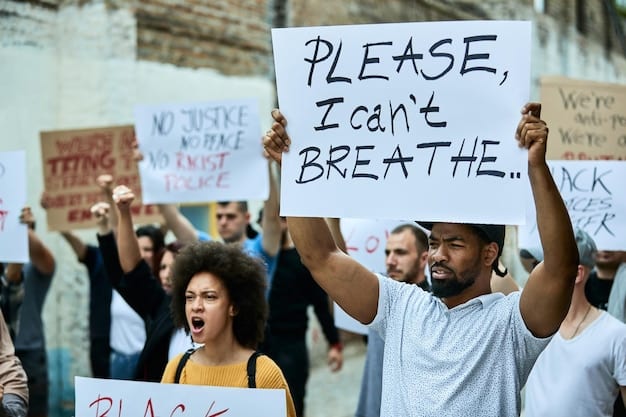Mandatory Minimum Sentencing: Justice or Injustice?

Exploring the arguments for and against mandatory minimum sentencing reveals a complex debate rooted in social justice, highlighting disparities, fairness, and effective crime reduction strategies within the US legal system.
The debate around exploring the arguments for and against mandatory minimum sentencing: a social justice perspective is a critical discourse in the US legal system. These laws, which require judges to impose a specific prison sentence for certain crimes, regardless of individual circumstances, have become a focal point in discussions about fairness, equity, and effective crime control.
Understanding Mandatory Minimum Sentencing
Mandatory minimum sentencing refers to laws that require a judge to impose a predetermined prison sentence for specific crimes. These sentences are set by legislation and take away judicial discretion, meaning judges cannot consider mitigating factors or individual circumstances when sentencing an offender. This approach has been controversial, with proponents arguing it deters crime and ensures consistency, while critics contend it leads to injustice and disproportionate punishment.
The Origins of Mandatory Minimums
Mandatory minimum sentencing laws gained prominence in the United States during the 1980s and 1990s as part of the “War on Drugs.” Lawmakers aimed to crack down on drug-related offenses and reduce crime rates by implementing strict sentencing guidelines. These laws were intended to target major drug traffickers and violent offenders, but their impact has extended far beyond these groups.
How Mandatory Minimums Work
Under mandatory minimum sentencing, if a person is convicted of a crime that carries a mandatory minimum sentence, the judge must impose at least the minimum term specified by law, regardless of the offender’s background, the nature of the offense, or any other extenuating circumstances. This can lead to situations where individuals with no prior criminal record or those who played a minor role in a crime receive lengthy prison sentences.

Mandatory minimums often involve drug offenses, firearm offenses, and repeat offenses. Penalties increase with the quantity of drugs involved or the type of firearm used, leading to significant sentences even for non-violent offenses. For example, possessing a certain amount of an illegal substance can trigger a mandatory minimum sentence of five, ten, or even twenty years in prison.
- Reduced judicial discretion: Judges are bound by law to apply the minimum sentence.
- Focus on quantity: Penalties often increase based on the amount of drugs or the type of weapon involved.
- Disproportionate impact: Can lead to severe sentences for non-violent offenders.
In conclusion, mandatory minimum sentencing laws remove judicial discretion and impose predetermined sentences, mainly affecting drug-related offenses and firearm violations. While proponents argue for their effectiveness in deterring crime, they have also been criticized for their potential to result in disproportionate penalties and exacerbate social injustices.
Arguments in Favor of Mandatory Minimum Sentencing
Proponents of mandatory minimum sentencing argue that these laws are essential for deterring crime, ensuring consistency in sentencing, and protecting public safety. They believe that strict penalties send a clear message to potential offenders and help to reduce crime rates by incapacitating repeat offenders.
Deterrence of Crime
One of the main arguments in favor of mandatory minimum sentencing is that it deters potential offenders from committing crimes. By making the consequences of criminal behavior severe and predictable, these laws are thought to discourage individuals from engaging in illegal activities. The idea is that the fear of a lengthy prison sentence will outweigh the potential benefits of committing a crime.
Some studies support the deterrence argument, suggesting that areas with stricter sentencing laws experience lower crime rates. However, others argue that deterrence is not the main driver, and factors like economic conditions, community policing, and social programs play a greater role in reducing crime.
Consistency in Sentencing
Another argument for mandatory minimums is that they promote consistency in sentencing. Without these laws, sentencing can vary widely depending on the judge, the jurisdiction, and the offender’s background. This can lead to disparities where similar offenders receive significantly different sentences, which can erode trust in the justice system. By eliminating judicial discretion, mandatory minimums aim to ensure that everyone who commits a particular crime receives the same punishment.
Incapacitation of Repeat Offenders
Proponents also argue that mandatory minimums are effective in incapacitating repeat offenders. By keeping criminals in prison for longer periods, these laws prevent them from committing further crimes in the community. This is particularly important for violent offenders and those with a history of repeat offenses.

Studies have shown that recidivism rates are high for certain types of offenders, indicating that they are likely to re-offend upon release from prison. Mandatory minimums can help to address this issue by extending the period of incapacitation and reducing the opportunity for repeat offenses.
- Deterrence: Discourages potential offenders with severe penalties.
- Consistency: Aims to ensure equal punishment for similar crimes.
- Incapacitation: Prevents repeat offenses by keeping criminals in prison longer.
In conclusion, advocates of mandatory minimum sentencing argue that these laws deter crime, promote consistency in sentencing, and incapacitate repeat offenders. While there is evidence to support these arguments, particularly regarding incapacitation, the broader impact of mandatory minimums on crime rates and overall fairness remains a subject of ongoing debate.
Arguments Against Mandatory Minimum Sentencing
Critics of mandatory minimum sentencing argue that these laws lead to unjust outcomes, disproportionately affect minority communities, and are ultimately ineffective in reducing crime. They contend that rigid sentencing guidelines undermine judicial discretion and result in sentences that do not fit the crime.
Unjust Outcomes
One of the main criticisms of mandatory minimum sentencing is that it can lead to unjust outcomes. Because judges are required to impose a specific sentence regardless of individual circumstances, offenders may receive penalties that are disproportionate to their role in the commission of the crime or their personal background. This can result in cases where first-time offenders or those who played a minor role in a crime receive the same sentence as major drug traffickers or violent offenders.
For example, a young person caught with a small amount of drugs might be subject to a mandatory minimum sentence that is far more severe than what a judge would have imposed had they been able to consider the person’s age, lack of criminal history, and other mitigating factors.
Disproportionate Impact on Minority Communities
Critics also argue that mandatory minimum sentencing laws have a disproportionate impact on minority communities. Studies have shown that these laws are applied more frequently and more harshly to Black and Hispanic defendants compared to white defendants. This disparity can contribute to racial inequalities in the criminal justice system and perpetuate cycles of poverty and disadvantage.
Research indicates that much of this disparity stems from differences in charging and plea bargaining practices. Minority defendants are more likely to be charged with offenses that carry mandatory minimum sentences and less likely to receive favorable plea deals that would allow them to avoid those sentences.
Ineffectiveness in Reducing Crime
Another argument against mandatory minimums is that they are ineffective in reducing crime. While proponents claim that these laws deter crime, studies have produced mixed results. Some research suggests that mandatory minimums have little or no impact on crime rates, and may even be counterproductive by diverting resources away from more effective crime prevention strategies.
Critics argue that focusing on rehabilitation, community policing, and addressing the root causes of crime would be more effective in reducing crime rates than simply imposing longer prison sentences. Investing in education, job training, and mental health services can help to prevent crime before it occurs, rather than simply punishing offenders after the fact.
- Unjust Outcomes: Results in disproportionate penalties due to inflexibility.
- Disproportionate Impact: Affects minority communities more harshly.
- Ineffectiveness: Shows limited impact on reducing crime rates.
In conclusion, critics of mandatory minimum sentencing argue that these laws lead to unjust outcomes, disproportionately affect minority communities, and are ineffective in reducing crime. By undermining judicial discretion and imposing rigid sentencing guidelines, mandatory minimums can result in penalties that do not fit the crime and may exacerbate social inequalities.
The Social Justice Perspective
From a social justice perspective, mandatory minimum sentencing raises significant concerns about fairness, equity, and the disproportionate impact on marginalized communities. Social justice advocates argue that these laws perpetuate inequality and undermine the principles of rehabilitation and restorative justice.
Fairness and Equity
One of the core principles of social justice is fairness, which requires treating all individuals equitably and impartially. Critics argue that mandatory minimum sentencing violates this principle by imposing harsh penalties without considering individual circumstances, leading to outcomes that are often unjust and disproportionate.
Social justice advocates believe that the criminal justice system should focus on addressing the root causes of crime, such as poverty, lack of education, and mental health issues. By investing in social programs and rehabilitation services, the system can help to prevent crime before it occurs and reduce recidivism rates.
Impact on Marginalized Communities
Another concern from a social justice perspective is the disproportionate impact of mandatory minimum sentencing on marginalized communities. Studies have shown that these laws are applied more frequently and more harshly to Black and Hispanic defendants compared to white defendants, contributing to racial inequalities in the criminal justice system.
Social justice advocates argue that addressing these disparities requires comprehensive reforms, including eliminating mandatory minimum sentencing, reforming drug laws, and investing in community-based programs that support marginalized communities.
Rehabilitation and Restorative Justice
Social justice also emphasizes the importance of rehabilitation and restorative justice. Instead of simply punishing offenders, the criminal justice system should focus on helping them to become productive members of society and repairing the harm caused by their crimes. Mandatory minimum sentencing, with its rigid and punitive approach, often undermines these goals.
- Fairness and Equity: Questions the impartiality of imposing harsh penalties without considering individual circumstances.
- Marginalized Communities: Highlights the disproportionate impact on Black and Hispanic defendants.
- Rehabilitation: Emphasizes helping offenders become productive members of society rather than strict punishment.
In conclusion, from a social justice perspective, mandatory minimum sentencing is seen as perpetuating inequality and undermining the principles of rehabilitation and restorative justice. Social justice advocates call for comprehensive reforms that address the root causes of crime, reduce disparities in the criminal justice system, and promote fairness and equity for all.
Alternatives to Mandatory Minimum Sentencing
Given the concerns about the effectiveness, fairness, and social justice implications of mandatory minimum sentencing, policymakers and advocates have proposed several alternatives aimed at achieving more just and effective outcomes. These alternatives include reforming sentencing guidelines, expanding drug treatment programs, and investing in community-based crime prevention initiatives.
Sentencing Guidelines Reform
One alternative to mandatory minimum sentencing is to reform sentencing guidelines to provide judges with greater discretion in individual cases. This would allow judges to consider mitigating factors, such as the offender’s background, the nature of the offense, and any other relevant circumstances, when imposing a sentence.
Sentencing guidelines reform can also involve reducing the severity of penalties for certain offenses, particularly drug-related crimes. This would help to address the problem of disproportionate sentences and reduce the number of individuals incarcerated for non-violent offenses.
Drug Treatment Programs
Another alternative is to expand access to drug treatment programs for individuals struggling with addiction. Drug addiction is often a root cause of crime, and providing treatment can help to break the cycle of addiction and reduce recidivism rates. Drug treatment programs can include medication-assisted treatment, counseling, and support groups.
By diverting individuals with drug addiction from the criminal justice system to treatment programs, communities can save money on incarceration costs and improve public health outcomes.
Community-Based Crime Prevention Initiatives
Another alternative is to invest in community-based crime prevention initiatives. These programs focus on addressing the root causes of crime, such as poverty, lack of education, and mental health issues. Community-based programs can include mentoring programs, after-school activities, job training, and mental health services.
- Sentencing Reform: Granting judges more discretion to consider individual circumstances.
- Drug Treatment: Expanding access to programs that combat substance abuse.
- Crime Prevention: Investing in community programs that combat root causes of crime.
In conclusion, by reforming sentencing guidelines, expanding drug treatment programs, and investing in community-based crime prevention initiatives, policymakers can create a more just and effective criminal justice system.
Moving Forward: A Balanced Approach
Addressing the complexities of mandatory minimum sentencing requires a balanced approach that considers the need for public safety, fairness, and rehabilitation. Policymakers, legal professionals, and community leaders must work together to develop effective strategies that reduce crime, promote justice, and support marginalized communities.
Data-Driven Decision Making
One important step is to rely on data and evidence to inform decision-making. Policymakers should conduct rigorous evaluations of the impact of mandatory minimum sentencing and other criminal justice policies to determine what works and what does not. This can involve analyzing crime rates, recidivism rates, and the costs and benefits of different approaches.
Data-driven decision-making can help to ensure that criminal justice policies are based on evidence rather than ideology or political considerations.
Community Engagement
Another important step is to engage community members in the discussion about criminal justice reform. Communities that are most affected by crime and incarceration should have a voice in shaping the policies that impact their lives. This can involve holding town hall meetings, conducting surveys, and establishing advisory boards.
Community engagement can help to build trust between law enforcement and community members and ensure that criminal justice policies are responsive to the needs and concerns of those who are most affected.
Restorative Justice Practices
Finally, it is important to promote the use of restorative justice practices. Restorative justice focuses on repairing the harm caused by crime and bringing together offenders, victims, and community members to find solutions. This can involve mediation, counseling, and community service projects. Restorative justice practices can help to reduce recidivism rates and promote healing and reconciliation.
In conclusion, by embracing data-driven decision making, community engagement, and restorative justice practices, policymakers and community leaders can create a more just and effective criminal justice system that promotes public safety, fairness, and rehabilitation.
| Key Point | Brief Description |
|---|---|
| ⚖️ Fairness Concerns | Mandatory minimums can lead to unjust outcomes due to inflexibility. |
| 🎯 Deterrence Debate | Effectiveness in deterring crime is debated, with data showing mixed results. |
| 🌱 Alternative Approaches | Sentencing reform and treatment programs offer promising alternatives. |
| 🤝 Community Impact | Disproportionate effects on minority communities raise social justice issues. |
Frequently Asked Questions (FAQs)
▼
Mandatory minimum sentences are laws that require judges to impose a minimum prison sentence for specific crimes, removing judicial discretion in sentencing decisions.
▼
Proponents argue that they deter crime, ensure consistent sentencing, and incapacitate repeat offenders, thereby enhancing public safety and justice.
▼
Critics contend that they lead to unjust outcomes, disproportionately affect minority communities, and are ineffective in significantly reducing crime rates.
▼
Studies show that these laws are often applied more harshly to Black and Hispanic defendants, worsening racial inequalities in the criminal justice system.
▼
Alternatives include sentencing guidelines reform, expanding drug treatment programs, and investing in community-based crime prevention initiatives to reduce crime and its root causes.
Conclusion
Exploring the arguments for and against mandatory minimum sentencing reveals a complex debate with profound implications for social justice. While proponents emphasize deterrence and consistency, critics highlight the potential for unjust outcomes and disproportionate impacts on marginalized communities. A balanced approach that prioritizes data-driven decision making, community engagement, and restorative justice practices is essential for creating a more equitable and effective criminal justice system.





